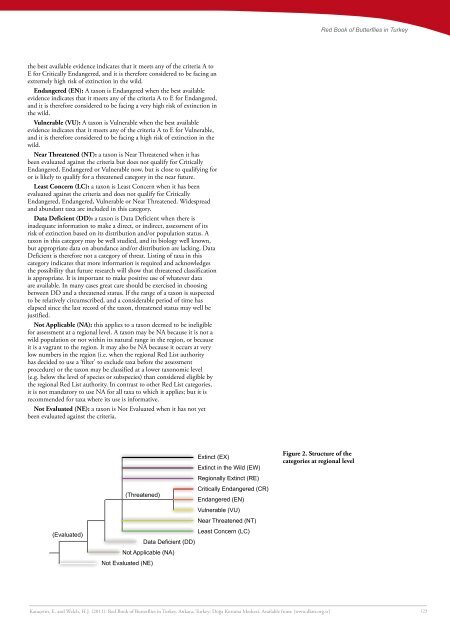Red Book of Butterflies in Turkey Red Book of Butterflies in Turkey
Red Book of Butterflies in Turkey Red Book of Butterflies in Turkey
Red Book of Butterflies in Turkey Red Book of Butterflies in Turkey
Create successful ePaper yourself
Turn your PDF publications into a flip-book with our unique Google optimized e-Paper software.
the best available evidence <strong>in</strong>dicates that it meets any <strong>of</strong> the criteria A to<br />
E for Critically Endangered, and it is therefore considered to be fac<strong>in</strong>g an<br />
extremely high risk <strong>of</strong> ext<strong>in</strong>ction <strong>in</strong> the wild.<br />
Endangered (EN): A taxon is Endangered when the best available<br />
evidence <strong>in</strong>dicates that it meets any <strong>of</strong> the criteria A to E for Endangered,<br />
and it is therefore considered to be fac<strong>in</strong>g a very high risk <strong>of</strong> ext<strong>in</strong>ction <strong>in</strong><br />
the wild.<br />
Vulnerable (VU): A taxon is Vulnerable when the best available<br />
evidence <strong>in</strong>dicates that it meets any <strong>of</strong> the criteria A to E for Vulnerable,<br />
and it is therefore considered to be fac<strong>in</strong>g a high risk <strong>of</strong> ext<strong>in</strong>ction <strong>in</strong> the<br />
wild.<br />
Near Threatened (NT): a taxon is Near Threatened when it has<br />
been evaluated aga<strong>in</strong>st the criteria but does not qualify for Critically<br />
Endangered, Endangered or Vulnerable now, but is close to qualify<strong>in</strong>g for<br />
or is likely to qualify for a threatened category <strong>in</strong> the near future.<br />
Least Concern (LC): a taxon is Least Concern when it has been<br />
evaluated aga<strong>in</strong>st the criteria and does not qualify for Critically<br />
Endangered, Endangered, Vulnerable or Near Threatened. Widespread<br />
and abundant taxa are <strong>in</strong>cluded <strong>in</strong> this category.<br />
Data Deficient (DD): a taxon is Data Deficient when there is<br />
<strong>in</strong>adequate <strong>in</strong>formation to make a direct, or <strong>in</strong>direct, assessment <strong>of</strong> its<br />
risk <strong>of</strong> ext<strong>in</strong>ction based on its distribution and/or population status. A<br />
taxon <strong>in</strong> this category may be well studied, and its biology well known,<br />
but appropriate data on abundance and/or distribution are lack<strong>in</strong>g. Data<br />
Deficient is therefore not a category <strong>of</strong> threat. List<strong>in</strong>g <strong>of</strong> taxa <strong>in</strong> this<br />
category <strong>in</strong>dicates that more <strong>in</strong>formation is required and acknowledges<br />
the possibility that future research will show that threatened classification<br />
is appropriate. It is important to make positive use <strong>of</strong> whatever data<br />
are available. In many cases great care should be exercised <strong>in</strong> choos<strong>in</strong>g<br />
between DD and a threatened status. If the range <strong>of</strong> a taxon is suspected<br />
to be relatively circumscribed, and a considerable period <strong>of</strong> time has<br />
elapsed s<strong>in</strong>ce the last record <strong>of</strong> the taxon, threatened status may well be<br />
justified.<br />
Not Applicable (NA): this applies to a taxon deemed to be <strong>in</strong>eligible<br />
for assessment at a regional level. A taxon may be NA because it is not a<br />
wild population or not with<strong>in</strong> its natural range <strong>in</strong> the region, or because<br />
it is a vagrant to the region. It may also be NA because it occurs at very<br />
low numbers <strong>in</strong> the region (i.e. when the regional <strong>Red</strong> List authority<br />
has decided to use a ‘filter’ to exclude taxa before the assessment<br />
procedure) or the taxon may be classified at a lower taxonomic level<br />
(e.g. below the level <strong>of</strong> species or subspecies) than considered eligible by<br />
the regional <strong>Red</strong> List authority. In contrast to other <strong>Red</strong> List categories,<br />
it is not mandatory to use NA for all taxa to which it applies; but it is<br />
recommended for taxa where its use is <strong>in</strong>formative.<br />
Not Evaluated (NE): a taxon is Not Evaluated when it has not yet<br />
been evaluated aga<strong>in</strong>st the criteria.<br />
(Evaluated)<br />
Ext<strong>in</strong>ct (EX)<br />
Ext<strong>in</strong>ct <strong>in</strong> the Wild (EW)<br />
Regionally Ext<strong>in</strong>ct (RE)<br />
Critically Endangered (CR)<br />
(Threatened)<br />
Endangered (EN)<br />
Vulnerable (VU)<br />
Near Threatened (NT)<br />
Least Concern (LC)<br />
Data Deficient (DD)<br />
Not Applicable (NA)<br />
Not Evaluated (NE)<br />
Figure 2. Structure <strong>of</strong> the<br />
categories at regional level<br />
Karaçet<strong>in</strong>, E. and Welch, H.J. (2011). <strong>Red</strong> <strong>Book</strong> <strong>of</strong> <strong>Butterflies</strong> <strong>in</strong> <strong>Turkey</strong>. Ankara, <strong>Turkey</strong>: Doğa Koruma Merkezi. Available from: [www.dkm.org.tr]<br />
<strong>Red</strong> <strong>Book</strong> <strong>of</strong> <strong>Butterflies</strong> <strong>in</strong> <strong>Turkey</strong><br />
123


